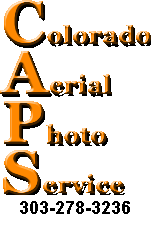


Home - Coverage
- Prices
How to Order - Office & Location
Color Photography
- Stereo Photography
FAQ -
About Us
- What is your email address and phone number?
- OUR NEW EMAIL ADDRESS IS: jpyoungCAPS@gmail.com NEW 303-278-3236
- How much will this cost me?
- It depends on what you want to do – research only, prints or digital files. Refer to the pricing page.
- How quickly can I get my order?
- Our standard turnaround time to pull research is 1–2 days. Our standard turnaround time to produce prints or digital images is 2-3 days. Unusually large or complicated orders may take longer. If you're in a time crunch for something, let us know and we can usually accommodate you.
- Can I view your library online?
- No. CAPS has about one million frames on film, hundreds more digital photos and several large digital data sets. Unfortunately, to scan, catalog, and upload that amount of data would be a huge, very expensive investment that is beyond our means.
- What resolution are your photos?
- Most of our photography is on film. We typically scan original negatives at resolution calculated to produce digital files output at 200 dots per inch (dpi) or printed at 200 to 300 dpi at the required size and scale. Each order is custom designed for best quality at the size ordered. The quality of the final image is dependent on such factors as: original scale of the film which can vary from 1" = 700' to 1" = 5000', quality of the film, quality of the camera used, and magnification factor necessary to arrive at the desired result.
Remember, every image, whether the source be film or digital, has a limit as to how much it can be enlarged. Despite what we see in the movies, images cannot be miraculously enlarged to unlimited detail. Other things being equal, the larger the negative scale, the more detail can be resolved. - Are the photos orthorectified and/or georeferenced?
- First of all, what do these terms mean? Simply put, an orthorectified photo has been corrected for distortion of the image caused by elevation changes on the ground, tilt of the camera, and lens distortion. Georeferencing refers only to digital files. The image file has associated data file(s) accessed by a GIS program that allows the image to be placed in its proper location on earth in relation to other georeferenced files (tif, dwg, shp, etc.).
Our images and film are not georeferenced. What we often do to correct an image scanned from film is to superimpose the scanned film image over an orthorectified digital image set to the same scale and dpi and then "rubber sheet" the image to produce a "best fit" photo. This is not a true orthorectification in that it has not been run through an orthorectification program using ground control and elevation models. For many purposes, especially when the terrain is relatively flat, this "best fit" transformation of the image is good enough. - Where do you get your photos?
- The majority of the photography is from our own archive of film. Unlike most private aerial photography companies that operate on a project-specific basis, CAPS has flown a grid up and down the Metro Denver area beginning June 12, 1948 and at least once a year thereafter through 2005. Much of Colorado's Front Range was covered for many years. We do have some coverage of the Eastern Plains, mountain towns and the Western Slope, but not as extensive or frequent as the Front Range Urban Corridor. CAPS has also acquired libraries from several other companies that flew mostly over Western Colorado and that film is also part of our archives. We have some 1937 photography from the US Forest Service.
